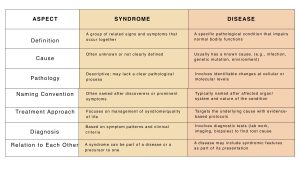- Open:Weekdays: 8:30 am – 5:30 pm, Saturdays: 9:00 am-2:00 pm
- Email: info@youdrugmart.com
Medical professionals often use the terms ‘syndrome’ and ‘disease’ interchangeably in the complex world of medicine. However, they hold distinct meanings and implications. “Understanding the difference between a syndrome and a disease helps clarify how medical professionals classify, diagnose, and treat various conditions. Let’s explore the key distinctions and complexities of syndrome and disease.
A syndrome is a collection of signs, symptoms, or characteristics that occur together and define a particular medical condition. Unlike a disease, a syndrome does not necessarily have a known cause or a specific pathological process. Instead, it is a descriptive term that identifies a group of related symptoms. Physicians often name syndromes after those who first described them or after the prominent symptoms they display.
Medical professionals recognize numerous syndromes. One well-known example is Down syndrome. Down syndrome presents distinct facial features, intellectual disability, and various health conditions, including heart defects and gastrointestinal issues. Another example is Turner syndrome, which affects females. Short stature, delayed puberty, and certain physical abnormalities characterize this condition. These syndromes share common sets of symptoms but may have different underlying causes or variations in severity among individuals.
A disease, on the other hand, refers to a specific pathological condition that impairs normal bodily functions. Unlike syndromes, medical professionals often trace diseases to a known cause, such as infection, genetic mutation, or environmental factors. A clear pathological process, including changes at the cellular or molecular level, generally characterizes diseases. Typically, experts name them based on the specific organ or body system affected, along with additional details about the condition itself.
Common examples of diseases include diabetes, Alzheimer’s disease, and asthma. Diabetes affects the body’s metabolism by raising blood sugar levels, typically due to insufficient insulin production or resistance to insulin. Alzheimer’s disease is a neurodegenerative disease that causes progressive cognitive decline, memory loss, and behavioral changes. Asthma is a chronic respiratory disease that narrows and inflames the airways, leading to wheezing, coughing, and difficulty breathing. These diseases have identifiable causes and well-established pathological processes.
It’s worth noting that a syndrome can be a part of a disease. In certain instances, a syndrome is a recognizable pattern of symptoms that arises from an underlying disease or condition. For instance, metabolic syndrome is a cluster of risk factors, such as high blood pressure, high blood sugar levels, abdominal obesity, and abnormal cholesterol levels. It’s associated with an increased risk of developing various diseases, including diabetes, heart disease, and stroke. In this context, metabolic syndrome is a syndrome within the broader context of diseases.
The diagnostic process for syndromes and diseases may vary. Syndromes are typically diagnosed based on the presence of a specific set of symptoms and signs. Healthcare professionals play a vital role in using diagnostic criteria or guidelines to determine whether the identified symptoms match a particular syndrome. In contrast, diseases often involve in-depth diagnostic testing, including laboratory tests, imaging studies, and biopsies. Identifying the underlying cause of a disease is crucial for appropriate management and treatment.

For diseases, the identifiable cause allows for targeted treatments that aim to address the underlying pathology or trigger. Treatment plans for diseases are often based on evidence-based guidelines and protocols specific to the diagnosed condition. Physicians can tailor treatments to combat the cause of the disease, manage symptoms, and even provide a cure in some cases.
On the other hand, since the cause of a syndrome may not be clearly understood, treatment focuses on managing the symptoms and improving the individual’s quality of life. Symptomatic treatment, such as pain management or physical therapy, is often used to alleviate presenting symptoms and enhance functioning.
Ongoing research and clinical trials may contribute to the development of more effective treatment approaches for both syndromes and diseases.
While the terms “syndrome” and “disease” are sometimes used interchangeably, they have distinct meanings in the medical field. Syndromes represent a group of related symptoms that occur together, whereas diseases refer to specific pathological conditions with identifiable causes. Understanding this difference empowers patients, healthcare professionals, and researchers to navigate the complex landscape of medical conditions, leading to more accurate diagnoses and appropriate treatment strategies.
